The Creosote Bush in our front yard is over 50 years old. This is pretty young for a creosote bush.
 The Friends of the Saguaro National Park's web site has an interesting page on the Creosote Bush which describes how the stem crown of the bush splits into separate crowns which are clones of the original, since they all originate from one seedling. This occurs between 30 and 90 years of age. The "King Clone" creosote in the Mojave Desert has an average diameter of 45 feet and is estimated to be 11,700 years old.
The Friends of the Saguaro National Park's web site has an interesting page on the Creosote Bush which describes how the stem crown of the bush splits into separate crowns which are clones of the original, since they all originate from one seedling. This occurs between 30 and 90 years of age. The "King Clone" creosote in the Mojave Desert has an average diameter of 45 feet and is estimated to be 11,700 years old.Our bush has responded to the recent rains and is flowering. The little yellow blooms are side by side with the fuzzy seed grey pods. Only a few of the pods will be capable of germinating.
 The flowers are attracting butterflies and bees.
The flowers are attracting butterflies and bees.

 In the past few years, our creosote bush has produced creosote galls on its stems. These are caused by the Creosote Gall Midge, Asphondylia aurinila, a small gnat-like insect, whose larva live in the protective tissue. This year's galls are green.
In the past few years, our creosote bush has produced creosote galls on its stems. These are caused by the Creosote Gall Midge, Asphondylia aurinila, a small gnat-like insect, whose larva live in the protective tissue. This year's galls are green.  Older galls turn brown.
Older galls turn brown. 
Healing Uses of Creosote Bushes (from the Friends of Saguaro National Park web site)
The Indians of the Southwest appreciated the creosote bush. The leaves were an important part of their pharmacopoeia. The Apaches prescribed chewing and swallowing a small piece of creosote branch to cure diarrhea. Other tribes made a strong tea from the dried leaves to treat the common cold. The resinous leaf nodes were used to soothe bruises and wounds. And a tea made from the leaves and sweetened with a little honey was said to greatly relieve kidney pain.
Modern herbalists also have found uses for the ancient creosote. An extract is now marketed as a cure for herpes. Another extract is being investigated as an anti-cancer drug. However, large doses of creosote have been shown to cause liver damage.

3 comments:
I always appreciate how you include native uses for plants in your posts, Pam. You give us a cultural introduction to your world as well as treat us to great photographs. :)
lené - There was so much fascinating info. on the Internet about the creosote bush. I was amazed at its influence on and importance to the desert. I could have written a term paper on it. Luckily, I've sworn never to take another class for credit ;)
Interesting plant! I think I saw it first in the Grand Canyon years ago when I went to visit.
Post a Comment